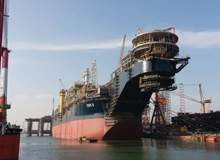
Tubarao Martelo (Waikiki) field is located within BM-C-39 and BM-C-40 blocks of the Campos Basin, which represents approximately 80% of Brazil’s oil production. The field lies in water depths of 110m, approximately 95km from Rio de Janeiro.
The field was declared commercial in April 2012 and drilling activities began in the second quarter of 2012. In December 2013, first production from the field occurred from the TBMT-8H well. Production from the third well named TBMT-2HP was announced in July 2014.
The development partners in the field include OGX as the operator holding a 60% interest, while Petronas holds the remaining 40% non-operating interest, which it acquired from the former in May 2013.
The installation licence for the field’s infrastructure was awarded to the operator by the Brazilian Institute for Environment and Renewable Natural Resources (IBAMA) in August 2013, and the operating licence was issued in November 2013.
Discovery, geology and reserves
The Waikiki complex, of which the Tubarao Martelo field is a part, was discovered through the 1-OGX-25-RJS wildcat well in December 2010. The well was drilled by Pride Venezuela semi-submersible drilling rig to a depth of approximately 3,000m.
The well confirmed the presence of hydrocarbons in carbonate reservoirs within the Albian-Cenomanian section. The offshore field is estimated to contain recoverable reserves of 285 million barrels.
Development of the Brazilian offshore field
The development of the Brazilian oil field primarily involved the installation of the host FPSO platform at a water depth of 110m and the installation of the WHP-2 wellhead platform. The subsea wells are connected via flow lines, risers and control umbilicals to the leased FPSO platform.
OSX-3 FPSO and WHP-2 platform details
The OSX-3 FPSO, converted from a very large crude carrier (VLCC), was named in May 2013 and was transported to the project site from the shipyard at Jurong, Singapore, in the third quarter of 2013. It was laid at the offshore site in October 2013 using five tug boats including Fairmount Marine’s Fairmount Glacier and Fairmount Expedition.
The FPSO is designed to operate at the oil field for 20 years without dry docking. It is 370m long and 57m wide and has a draft of 31m. It is made up of 16 modules weighing 1,480t each and has a production capacity of up to 100,000 barrels of oil per day, storage capacity of up to 1.3 million barrels, in addition to seawater treatment and injection capacity of 150,000bwpd.
The WHP-2 platform is 115m high and weighs approximately 23,000t.
Contractors involved
The $800m engineering, procurement, construction and installation (EPCI) contract for the FPSO was awarded to Modec, while the FPSO topsides were collaboratively installed by Modec and Toyo Offshore Production Systems (MTOPS).
Lapa Oilfield is located approximately 270km off the coast of Sao Paulo, in water depths of approximately 2,140m.
The modularisation design for the FPSO topsides was carried out by L&T-Valdel Engineering using SACS and STAAD.Pro softwares, which reduced construction time and steel consumption by 10%.
Five units of the FPSO’s topside modules were fabricated and installed by Dyna-Mac Engineering Services in collaboration with HASKem. The mooring chain and shackles for the FPSO were supplied by Sanmar Chain International (SCI).
The ABS classed cantilevered bow turret mooring system for the FPSO was designed and constructed by Sofec, a subsidiary of Modec. The commissioning procedures for the turret mooring system were delivered by Maderra Engineering.
The EPCI contractor for the WHP-2 was Techint, who subcontracted EBSE to construct the jacket modules. The control safety system (CSS) for the facility was supplied by SIX Automação.
GE supplied the subsea and surface drilling and production equipment for the production platform and a subsea template / tieback system.











